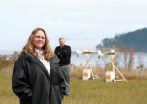"The public investment in research universities has led to a great deal of new knowledge that can benefit society, and the movement of research results to those who can commercialize them creates jobs and strengthens the economy, contributes to the advance of human health, and adds to the nation's security," said Mark S. Wrighton, chair of the committee that wrote the report, and chancellor and professor of chemistry at Washington University in St. Louis. "The movement of intellectual property from universities to new and mature companies is a healthy process, but one that can be improved. Our committee's report provides some recommendations for those involved in this transfer of knowledge."
University leaders should articulate a clear mission for intellectual property management -- one that stresses the responsibility to disseminate technologies for the public good and does not predicate licensing on the goal of raising significant revenue for the university -- and should evaluate their institutions' efforts accordingly, the report says. Universities also should consider additional ways to engage faculty in commercializing their inventions, as successful commercialization often depends on inventor involvement. In addition, because Bayh-Dole did not establish a stable, effective framework for government oversight, such responsibilities should be clearly assigned within the federal bureaucracy, the report says.
Before the Bayh-Dole Act, if government agencies funded university research, the funding agency retained ownership of the knowledge and technologies that resulted and could license them to companies, who in turn could use it to develop new products and services. However, very little federally funded research was actually commercialized, the report notes. The Act's passage brought more uniformity to the way agencies treat inventions and allowed universities to take title in most cases. As a result, patenting and licensing activity from such research has accelerated in the 30 years since the Act's passage.
Although the system created by the Act has remained stable, it has generated debate about whether it might impede other forms of knowledge transfer. Concerns have also arisen that universities might prioritize commercialization at the expense of their traditional mission to pursue fundamental knowledge -- for example, by steering research away from curiosity-driven topics toward applications that could yield financial returns. The only alternative system to attract support is a "free agency" system, which would give individual faculty members either ownership of their inventions or the freedom to market them independently while the university retains ownership.
The report concludes that the Bayh-Dole framework and university practices have not seriously undermined academic norms of uninhibited inquiry and that there is little evidence that intellectual property considerations interfere with other important avenues of transferring research results to commercial use. Nor has a persuasive case been made for shifting to a free agency system.
Nevertheless, proposals to give faculty ownership or the rights to market their inventions reflect a feeling in some quarters that the current system does not sufficiently value faculty initiative. Universities seeking to encourage entrepreneurial initiative should consider creating expedited procedures and more standardized terms for licensing to start-up enterprises in which staff, faculty, or students are involved, the report says. In addition, there should be independent oversight of the relationship between faculty and university technology transfer offices, and faculty who believe their inventions are being ignored or mishandled should have recourse within their institution. Such disputes should be resolved by an advisory committee composed of university faculty, employees, and administrators.
Institutions with sizable research portfolios should also consider creating an additional standing advisory committee to help the technology licensing unit identify opportunities and develop practices consistent with the university's goals. Such committees should include representatives of research parks and business incubators affiliated with the university, relevant business and investment communities, and other stakeholders.
Smaller institutions and those with less research experience who want to strengthen their technology transfer should consider permitting greater outreach by faculty to pursue the entrepreneurial development of their ideas, collaborating with larger institutions in the same region, or outsourcing certain functions or technology fields to private entities with skills and contacts, the report says.
The report adds that, although effective in its primary purpose, the Bayh-Dole Act's authors and implementers failed to establish a stable, effective framework for governmental oversight. Perhaps by executive order, there should be a clear assignment of oversight responsibilities, which include ensuring that all agencies consistently implement federal technology transfer laws and heading an interagency committee on technology transfer, among other responsibilities.
INFORMATION: The study was funded by the Andrew W. Mellon Foundation, John D. and Catherine T. MacArthur Foundation, Robertson Foundation, Ewing Marion Kauffman Foundation, Burroughs Wellcome Fund, an anonymous foundation, FasterCures Center, Milken Institute, HighQ Foundation, Myelin Repair Foundation, and Doris Duke Charitable Foundation. The National Academy of Sciences, National Academy of Engineering, Institute of Medicine, and National Research Council make up the National Academies. They are private, nonprofit institutions that provide science, technology, and health policy advice under a congressional charter. The Research Council is the principal operating agency of the National Academy of Sciences and the National Academy of Engineering. A committee roster follows.
Copies of Improving University Management of Intellectual Property in the Public Interest are available from the National Academies Press; tel. 202-334-3313 or 1-800-624-6242 or on the Internet at http://www.nap.edu. Reporters may obtain a copy from the Office of News and Public Information (contacts listed below).
Contacts: Sara Frueh, Media Relations Officer
Christopher White, Media Relations Assistant
Office of News and Public Information
202-334-2138; e-mail news@nas.edu
[ This news release and report are available at http://national-academies.org ]
NATIONAL RESEARCH COUNCIL
Division on Policy and Global Affairs
Board on Science, Technology, and Economic Policy
Committee on Science, Technology and Law
Committee on Improving University Management of Intellectual Property in the Public Interest
Mark S. Wrighton (chair)
Chancellor and Professor of Chemistry
Washington University
St. Louis
Mark C. Fishman1 (vice chair)
President and Chief Executive Officer
Novartis Institutes for BioMedical Research Inc.
Cambridge, Mass.
Craig A. Alexander
Vice President and General Counsel
Howard Hughes Medical Institute
Chevy Chase, Md.
Margo A. Bagley
Professor of Law
University of Virginia
Charlottesville
Wendy H. Baldwin
Director
Poverty, Gender, and Youth Program
The Population Council
New York City
Alan B. Bennett
Executive Director
Public Intellectual Property Resource for Agriculture, and
Associate Dean
Department of Vegetable Crops and Weed Science Program
University of California
Davis
Wesley Marc Cohen
Frederick C. Joerg Professor of Business Administration and Professor of Economics
Fuqua School of Business
Duke University
Durham, N.C.
Robert M. Cook-Deegan
Director
Center for Genome Ethics, Law,
and Policy
Institute for Genome Sciences
and Policy
Duke University
Durham, N.C.
Mark S. Kamlet
Provost and Professor of Economics and Public Policy
Carnegie Mellon University
Pittsburgh
Greg Kisor
Vice President and Portfolio Architect
Intellectual Ventures
Palo Alto, Calif.
David Korn1
Vice Provost for Research
Harvard University
Cambridge, Mass.
Katharine Ku
Director
Office of Technology Licensing
Stanford University
Palo Alto, Calif.
Edward D. Lazowska2
Bill & Melinda Gates Chair in Computer Science and Engineering
University of Washington
Seattle
Marshall C. Phelps Jr.
Corporate Vice President
Intellectual Property Policy and Strategy
Microsoft Corp. (retired)
Redmond, Wash.
Dorothy K. Robinson
Vice President and General Counsel
Yale University
New Haven, Conn.
N. Darius Sankey
Managing Director
Zone Ventures
Los Angeles
Jerry G. Thursby
Professor and Ernest Scheller Jr. Chair
in Innovation, Entrepreneurship, and
Commercialization
College of Management
Georgia Institute of Technology
Atlanta
Jennifer L. West
Isabel C. Cameron Professor and Director
Institute of Biosciences and
Bioengineering
Rice University
Houston
STAFF
Anne-Marie Mazza
Study Director
1 Member, Institute of Medicine
2 Member, National Academy of Engineering

